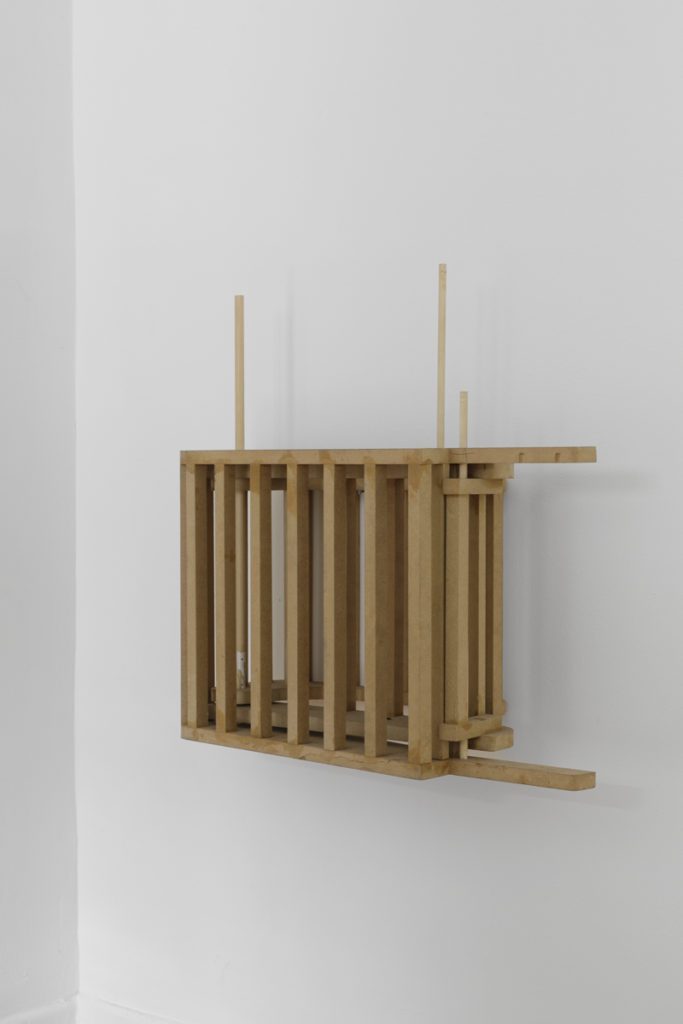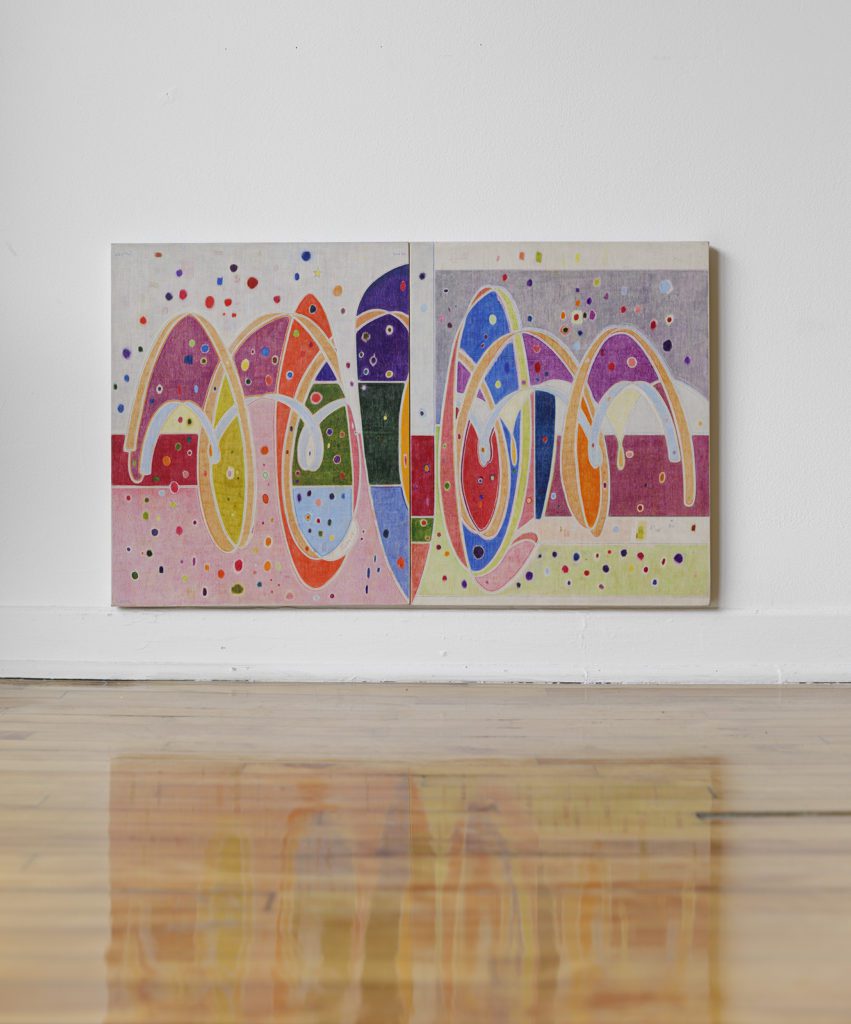Marlon Kroll at Parc Offsite
4 August 2023By Rosemary Flutur

Let us assume that an artist is a translator of what constitutes them. Even the most ostensibly impersonal art is a revelation of the artist’s curiosities and desires, and the more empathetic viewer enacts a form of deciphering. My tendency, or perhaps my problem, is that when a work of art moves me, I experience a vague desire to gather information about the artist, not unlike the energy that coils inside me when I have a crush: when were they born; what motivates them to live; did they have a difficult childhood? Unless you’re personally acquainted with the individual (and even then), one has to turn to the contentious landscapes of history or gossip to fill in the gaps. Context doesn’t necessarily offer clearer insight, but it can affect the impact. It also helps with identifying whether or not the artist is privy to artmaking’s capacity to reconfigure their ontology, which occurs when treating the act as one of great intimacy between material and maker.
At first glance, artist Marlon Kroll’s show Fireflies, at Montréal’s Parc Offsite, is like his many others: an exciting collection of distinctly stylized works that are clearly bred from a steady toiling. What is unique in this case, however, is the exhibition text, which takes form as an epistolary note to the gallery’s founder and director Eli Kerr, and was penned by the artist himself. The text, modest in tone, is a candid imparting of recent incidents and revelations that have transpired in his personal life and how they’ve helped him arrive at new understandings of his work.1 Most notable is the death of his mother. Kroll, a former Waldorf School student, writes that this event, among others, led him to reconsider the overarching spiritual locus of his upbringing, one that he for many years challenged. Most significant was a watershed moment that occurred after his last show in Naples, in which he came to see the exhibited drawings and sculptures with their visual references to trumpets and horns as no longer strictly figurative, but numinous.

Fireflies is the first solo show containing work that Kroll has made under the auspices of this new perspective. The pieces follow the same aesthetic track he’s ambulated down over the course of his practice: an ingenious combination of visual references that span the banally familiar to unsettlingly vague, crafted into scenes that are simultaneously figurative and abstract. Moving easily between pencil drawings, readymade sculptures, and ceramics, the enigmatic content of his oeuvre has led other critics to use terms like “ambiguous” and “uncanny” when describing it.2 But the work’s resistance to categorization is mostly a natural eliding of such. The difficulty with figuring it out is part of its essence because of how much the works contain and hence can offer the viewer.
Kroll thus avoids what poet and writer John Ashbery describes as the “horror” of the artist who “treats art as though it were raw material for a factory that produces a commodity called understanding.”3 Ashbery’s point, besides criticizing art too shallow to require any searching, is that this “commodity” (or lone idea, in this context) is merely a fragment of the whole: it may lead to what ostensibly could be understanding, but is actually just a narrow scope of a wider purview. Some art that takes time to discern isn’t necessarily abstruse either, since the protracted awareness comes from how much the work holds—the “reality of the ensemble,”4 as Ashbery calls it—and how small our assumed knowledge is in the face of so much. Kroll’s work, intrinsically equivocal, supports what I believe to be an argument for confusion, even frustration, when interacting with certain art, which exposes our cognitive limitations. Implicit is a request for rumination and humility.

The works in Fireflies concern what we cannot immediately, or perhaps ever, see. They are about being on the cusp of a literal and metaphorical edge and are crafted in a quasi-jocular manner that is Kroll’s bent, yet the playfulness of the works do little to dilute the strange and even grave feeling one gets when proximity to the unknown contracts. Janice (2023)—the trumpet-cum-furnace wooden sculpture with beige manila-paper skin—Kroll describes as an “effigy and offering to an ancient god … the protector of portals” in the exhibition text. Vivid pencil drawings hang inconspicuously at ankle height or lay supine on the gallery office shelf, referencing entrances to other realms, like hidden magnetic portals or wormholes. Bellowing (2023), a movable wall-hanging structure of MDF and wooden dowels, is the most playful of the works: he describes it as the “operator and passenger of [an] interdimensional shuttle.”5 While Kroll’s art has always been an attempt to go beyond the known realm while using its forms and cues, what he exhibits in Fireflies feels more like an observation from this realm without an attempt to transgress it; rather, it is an acknowledgement and reverence of and for those very cusps, the entry points between one reality and the next.
Kroll’s work has been described as a form of “speculative anthropology,”6 which I particularly like. My mind initially turned to “speculative fiction,” the literary genre that encompasses fiction that deviates, either somewhat or greatly, from the real world, as a light or serious criticism of its conditions. But while speculative fiction has more to do with the world itself, speculative anthropology, as I understand it, hones in on the particularities of human nature. In this context the phrase suggests: what are other ways of approaching being, of behaving? The speculative exercise, at its most generative, grants access to different registers of feeling and thinking about what it is to be and to become. Speculative anthropology seems, then, a convenient means to ontological reconfiguration. It is as much a part of Kroll’s art practice as it is his personal life, which both dwell in the same interior.

There is something I’ve always thought about Kroll’s pencil drawings in particular, and it’s how visually similar they are to Hilma af Klint’s work: they both share the condition of being penetrating abstractions of complex spiritual ideas, though I’ve always seen Kroll’s as more masculine, despite this word being somewhat moot. But thanks to the exhibition text, which offered insightful context, I began to consider the connection between the two artists differently. Although af Klint never attended the Waldorf School (and was even artistically dismissed by its founder, Rudolf Steiner, in what one writer called “the worst studio visit of all time”7) she was a theosophist, the movement from which anthroposophy, the philosophy Steiner developed and adapted in the Waldorf School curriculum, takes root. Kroll and af Klint’s recent lineages may run tangential, but at one point they emerged from the same source. It’s no wonder their work vibrates at the same frequency.
I wonder what Kroll’s revelations, spiritual in nature, will do to and for his work moving forward. Perhaps the drawings that evoke af Klint’s will evolve into something that are even more his own, or perhaps he will abandon drawing altogether. But if this hashing out of his origins continues, then changes—overt or subtle—will occur, as is the typical result of a personal exegesis, of integrating one’s gone reality into their present configuration. When this course of action is taken by an artist, I always wonder what effect it will have on their art. In the case of Kroll, whose art has already championed the unknown, it feels as if the work may become a more realized version of what he has already scrupulously explored: a way to bring together many worlds—the real, the fantastical, what can be touched, and what can only be imagined. Artistically, Kroll seems to be at a door; and to be at a door is to be concerned with the matter of stepping through.
- Marlon Kroll, Fireflies, Parc Offsite, April 21, 2023, Exhibition text, https://files.cargocollective.com/c821071/Marlon-Kroll-Fireflies-Text-April-21-2023.pdf.
- James D. Campbell, ”Immanence, charisma, and the category mistake,” Whitehot Magazine, July 2019, https://whitehotmagazine.com/articles/immanence-charisma-category-mistake/4353.
- John Ashbery, “Things as They Are,” The New York Review, February 3, 1983, https://www.nybooks.com/articles/1983/02/03/things-as-they-are/.
- Ibid.
- https://files.cargocollective.com/c821071/Marlon-Kroll-Fireflies-Text-April-21-2023.pdf
- “Artist of the Week: Marlon Kroll,” LVL 3, November 21, 2019, https://lvl3official.com/marlon-kroll/.
- Jerry Saltz, “The Future Belonged to Hilma af Klint,” Vulture, September 6, 2018, https://www.vulture.com/2018/09/hilma-af-klint-paintings-for-the-future-at-guggenheim.html.
Fireflies by Marlon Kroll ran from April 22 – May 27, 2023 at Parc Offsite in Montréal, QC.
Feature Image: (left side) Bowlahoola, 2023; (right side) Gabriel’s Horn, 2023 by Marlon Kroll. Photo courtesy of Parc Offsite.



